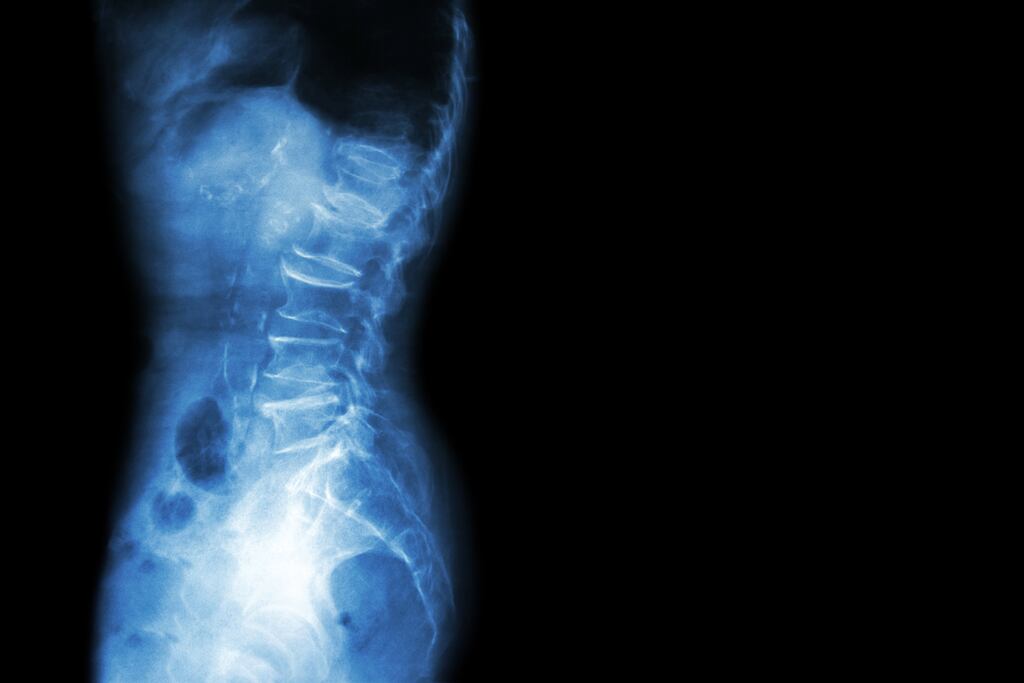We’re all guilty about making wry jokes relating to the aches and pains that become commonplace as we get older, but for some people, aching joints and constant exhaustion are part and parcel of life from a young age.
Emma O’Carroll began experiencing lower back pain in her early 20s, but because it was relatively mild at the time, she didn’t give it too much thought. A couple of years later, though, in 2019, she had suffered enough and decided to seek medical advice.
“It started as a pinching discomfort in my lower back which gradually spread upwards until my entire spine was affected,” she says. “Then I started having drenching night sweats, with terrible pain both at night and first thing in the morning. I didn’t get more than two or three hours of unbroken sleep and would wake with severe stiffness and pain, as though I had been impaled through the chest and encased in concrete.
“I couldn’t sit up in bed, so would have to roll on to the floor to get up or wake my partner to help me. And I spent hours every night hunched over and pacing the floor with a heat pack before it eased enough for me to go back to bed. I was also really stiff, particularly around my chest and upper back, and couldn’t take deep breaths. I then started getting pains in my heels, so wearing shoes or standing was agony. My knees also got very red and swollen, especially at night – you could feel the heat radiating off them.”
READ MORE
After seeking medical advice in 2019, she didn’t start treatment for two years, even though her rheumatologist suspected that symptoms had been brewing for a long time. “I had a few visits with a GP who, without any scans, bloods or physical examinations, said my symptoms were due to anxiety and laziness,” she says. “Instead, I was given antidepressants. I was devastated, really beginning to believe that my mind was deceiving me – I lost all confidence in myself.
“A few months later, I built up the courage to go to a different doctor who diagnosed me with a herniated disc and suggested physiotherapy. Again, this was without any proper investigations – and I got steadily worse. It was the physiotherapist who advised me to get another opinion, reassuring me that there were observable physical issues with my spine.
“I really had to fight for myself at this point. Luckily, since I was working in healthcare and medically literate, I knew what I needed to do, so asked a doctor colleague to test my blood for the HLA-B27 gene and to refer me for an MRI and to a rheumatologist.”
[ Rheumatoid arthritis: What is it, who gets it and what does the future hold?Opens in new window ]
The now 32-year-old says she knew that the waiting list for rheumatology “was dire” so rang several clinics explaining her “desperation”. She was told repeatedly that no new patients were being taken at that time. However, eventually, she was offered an appointment in 2021.
“I was diagnosed with axial spondyloarthritis (AS) at my first consultation and remember how disgusted but unsurprised the rheumatologist was at how I had been treated until that point,” she says. “He told me that it is a common phenomenon for women’s pain to be dismissed or ignored and that my condition was quite obvious.
“I felt relieved that I knew what I was dealing with, so could do something about it and was thankful I didn’t get worse news. I also felt so relieved that someone finally acknowledged what I was going through and I could say that I had a legitimate condition and am not lazy or overthinking.
“But the relief didn’t last too long as I quickly started feeling like no one could really understand me. I felt real fear. I was to turn 30 in a few months and it was terrifying not to know what my life was going to look like – how I would manage work, start a family or buy a house, when everything was so up in the air and likely to change at any given moment.
“I was also going through a type of grief. I had to let go of the expectations I had for myself and accept a new and unpredictable reality. That can be very painful when it feels like everyone around you is settling down and progressing with their lives. I mourned the health and freedom I had before, felt resentful that I had to deal with this and angry at the way I, and so many others, had been neglected and dismissed – but was also annoyed at myself for being upset when others have it so much worse.”

The Cork woman, who is unable to work at present due to her condition, says that AS had been negatively affecting her life for years, but thanks to medical intervention, things have much improved. “I was barely sleeping and missing work because I couldn’t even get myself up and dressed. It was really tough on my partner too, who was waking several times a night with me and it put more of the burden of covering our rent and bills on him. I had to rely on my parents to help with medical costs.
“I became very withdrawn as I didn’t have the stamina or mindset for engaging with anyone and was feeling completely defeated – just dragging myself through life at that point. Everything, even standing on a bus or drying my hair, became a struggle and sitting in a car or on a plane for a few hours would leave me feeling like I was made of wood. I was forced to give up my post-graduate training in radiography and the mental torment was as bad as the physical pain as I had constant anxiety.
“I felt ashamed that I was struggling so much even though I was young and looked physically able-bodied. I just felt like I was failing at life and letting everyone down. But since starting treatment (medication, physiotherapy, acupuncture and exercise) I am doing so much better. It almost feels like a bad dream and I wondered how I managed to get through it.
“I also took part in a mental health programme run by Arthritis Ireland, which really helped me address the difficult emotions which come with chronic pain and fatigue. Living with a chronic condition is really challenging on your mental health and when you’re consumed with physical symptoms it is easy to neglect this. The skills for self-care and compassion are an essential part of my treatment.”
Emma, who is a part-time student of TCM (traditional Chinese medicine) and acupuncture at Irish College of Traditional Chinese Medicine in Dublin, would advise anyone else who is suffering to listen to their bodies and never give up trying to find answers. “Trust yourself and what your body is telling you – you are the expert on your condition and your experience is equally as valid as any medical investigations or opinions. Also, be kind to yourself, accept help, learn to say no to things and let go of any guilt. The people who really matter will move mountains to support you but it is your responsibility to share your needs.
“Also, I would encourage people to be as educated as they can about their condition and treatment so they can make informed decisions with their healthcare team. You have to be your biggest advocate. Your care is a partnership with your physician. Arthritis Ireland (helpline: 0818 252 846) are a fantastic organisation to link in with because of the huge range of free supports and information they offer. There is so much to be gained from meeting people with a shared experience.
“But, there can be a lot of misinformation and negativity online, so it’s important to remember that everyone’s journey is unique and treatments are improving all the time. The future is a lot brighter for people with rheumatic disease than it was even 10 years ago, so don’t lose hope.”

Axial spondyloarthritis
- Axial spondyloarthritis (axSpA) is an inflammatory form of arthritis where the main symptom is back pain and changes can be seen to the sacroiliac joints on X-rays.
- It is a painful, chronic inflammatory disease, which primarily affects the spine and sacroiliac joints. However, feet, knees and ankles can also experience pain and stiffness, along with other symptoms such as sclerosis, inflammatory bowel problems and uveitis.
- The main symptom is inflammatory back pain, but some people also experience pain, stiffness and limited mobility outside of the spine, such as in their neck, shoulders, hips, chest, knees and even heels. Morning stiffness and pain can also occur, typically wearing off during the day, particularly with activity and movement.
- The incidence of axSpA in Ireland is low. It is estimated just 0.5 per cent of the population is affected by the condition.
- It is most common in late adolescence or early adulthood and risk factors can also include genetics, viral infections and environmental factors such as smoking.















